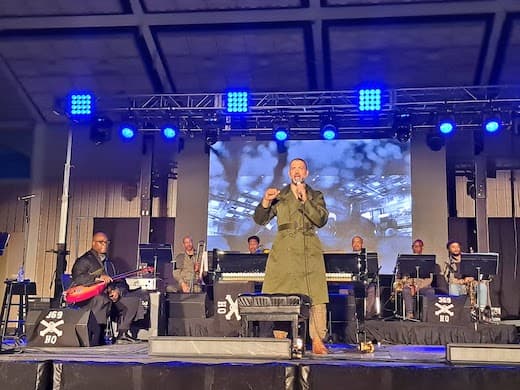Jason Moran Marches to the Drum of James Reese Europe
As is made clear by the title of the pianist’s new celebration of Europe’s music, Lieutenant Europe and his men distinguished themselves both musically and militarily as the 369th Infantry Regiment band.

Jason Moran
‘From The Dancehall To The Battlefield’
Yes Records
One of the very first serious discussions of jazz was published in a 1924 book by Gilbert Seldes, “The Seven Lively Arts.” In discussing the music in racial terms — as people were wont to do back then — Seldes observes that the very best of the Caucasian bandleaders, “by a little joke, is called Whiteman.” If that’s humor, then this, by the same standard, is irony: Even before Paul Whiteman, the maestro who did the most to lay the groundwork for the coming of jazz, and indeed, much of subsequent American music, was named Europe.
James Reese Europe (1880-1919) was a pioneering Black bandleader who was easily the dominant figure in all of American music in the 1910s. It’s not a stretch to identify him as the link between such earlier avatars of American music as march king John Philip Sousa and ragtime king Scott Joplin and the first superstar jazz ensembles like Fletcher Henderson and Duke Ellington.
Further, as is made clear by the title of pianist Jason Moran’s new celebration of Europe’s music, “From The Dancehall To The Battlefield,” Lieutenant Europe and his men distinguished themselves both musically and militarily as the 369th Infantry Regiment (the “Harlem Hellfighters”) band during what was then known as “The Great War” or “The European War.”
Mr. Moran’s project takes two forms, an album (also available as a two-LP set) and a live concert presentation, which he performed last Friday under the auspices of JazzMobile at the uptown park named after another African American thought leader of the same era, Marcus Garvey.
Now 48, Mr. Moran is well known as a purveyor of what we think of as the most far-out jazz being played today, a direct extension of the free jazz of the 1960s. At the same time, he has the deepest respect for and knowledge of the entire history — or even, in this latest project, the pre-history — of jazz.
Previous projects have found Mr. Moran re-imagining the music of such piano predecessors as Fats Waller and Thelonious Monk, and he has also done a spectacular job in curating an exhibit of Louis Armstrong’s effects and personal memorabilia currently on display at the newly opened Louis Armstrong House Museum at Corona.
Mr. Moran has taken a dozen or so themes of the era, including popular songs (“The Darktown Strutters Ball”), dances (“Ballin’ the Jack”), blues (three by W.C. Handy, “St. Louis Blues,” “Memphis Blues,” “Hesitating Blues”), numerous rags, and a folk tune, “Make me a Pallet on the Floor.” He and his 10-piece ensemble, which includes both an electric string bass and a tuba, will often start with a highly faithful recreation of an historic Europe performance (as preserved and documented on acoustic recordings) and then will gradually work it into something else.
In some cases, as with “Darktown Strutters,” he’ll update the piece into something more modern, from a raggy 2/4 into a swinging four. “Russian Rag” travels from the dancehall to the battlefield and even beyond, into a downtown jazz loft of the kind we frequented in the early ’70s.
“That Moaning Trombone” is a ragtime virtuoso piece that spotlights both of the sliphorn players here, Reginald Cyntje and Chris Bates, and also emphasizes Jose Davila on tuba. “All of No Man’s Land is Ours” is co-credited to Europe and Noble Sissle, then a violinist with the 369th, who also sings on the original 1919 recording. Mr. Moran recasts it as a lovely ragtime piano ballad in the style of Europe and Sissle’s great associate, Eubie Blake.
While the album is terrific, the concert incarnation is an even more remarkable experience. Mr. Moran and his men take the stage dressed in vintage World War I military uniforms, and he frames the work with narration he delivers himself, discussing Europe and his impact on American music in agreeably poetic terms. Then, the 10-piece ensemble performs in front of a slide show of mostly historic images and even some newsreel footage — the Harlem Hellfighters famous march up Fifth Avenue, perhaps the first time a crowd of mostly white people cheered an all-Black organization of any kind.
One of the work’s centerpieces is “Flee as a Bird,” in which the ensemble starts with a spiritual and dirge traditionally played at New Orleans funerals. They literally deconstruct it in front of our ears, carrying it to the furthest extremes of what jazz is, incorporating “Ghosts,” a 1960s avant-garde dirge by postmodern saxophonist Albert Ayler.
Perhaps we shouldn’t read too much into Mr. Moran’s treatment of a piece that is clearly about death and the afterlife. It was Eubie Blake who described Europe as the “Martin Luther King of music,” and unfortunately, they both were murdered at roughly the same age. Mr. Moran closes the work with a wholly original piece titled “For James.” This project is one of the very few that would satisfy lovers of both the earliest traditional jazz and the most modern “outside” music. Somehow, it’s Black history and Afro-Futurism at the same time.

